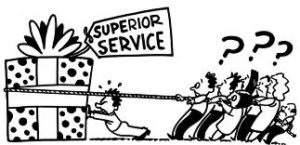 The service concept is a shared understanding of what the organization provides and what the customer receives. Although it’s a simple idea, the service concept is powerful and can be used as a central tool in the design, delivery and improvement of services. In fact, concepts are what customers actually buy, not the elements of service.
The service concept is a shared understanding of what the organization provides and what the customer receives. Although it’s a simple idea, the service concept is powerful and can be used as a central tool in the design, delivery and improvement of services. In fact, concepts are what customers actually buy, not the elements of service.
For instance, an MBA student buys ‘employability’ from the business school and not the elements of service like lectures, books, and certificate. Similarly, a hotel guest buys ‘a relaxing and pampered stay’ and not bed space, bathroom space, and food. So customers buy something much greater and usually more intangible – the concepts.
However, for the service concept to be useful, it needs to contain more detail than the central themes or ‘organizing ideas’ shown in the examples.
It should have information about:
The organizing idea: The essence of the service bought, or used, by the customer.
The service experience: The customer’s direct experience of the service process, which concerns the way the service provider deals with the customer.
The service outcome: The result for the customer of the service (in particular, the benefits provided, the resulting emotions and assessment of value for money).
Your service concept should provide sufficient detail to make it clear what your organization is selling and what your customer is buying. It should represent the nature of your service, so as to guide operations staff and managers to know what to deliver and how to deliver it and help marketing know what to offer to the marketplace.
Hence the service concept is something very important. But surprisingly, in many service organizations, it’s not often articulated, shared, and understood. And this is one of the most common causes of poor service because it’s the service concept that helps to integrate the various functions of a service organization. So if it’s not well defined and agreed, the service organization fails to gain alignment.
This results to individuals, customers and staff having different views of the service. For example, operations managers may be concerned about managing the process, staffing problems and operational costs. Marketing may be concerned about brand development, new opportunities and revenue generation. Customers may be concerned about the experience, price and value. These valid, but nonetheless differing perspectives and priorities often result in functional myopia, leading to actions that are functionally appropriate but internally, and externally, inconsistent.
To eradicate such inconsistency, organizations must make the nature of their service explicit by ensuring a clear and appropriate concept message to both employees and customers. This will help to unite them and ensure appropriate, and consistent, service delivery.
Hence the service concept and its development is a core task in managing service operations. If your organization does not have a clearly defined service concept, why don’t you start the year with one?
Have a great New Year!

